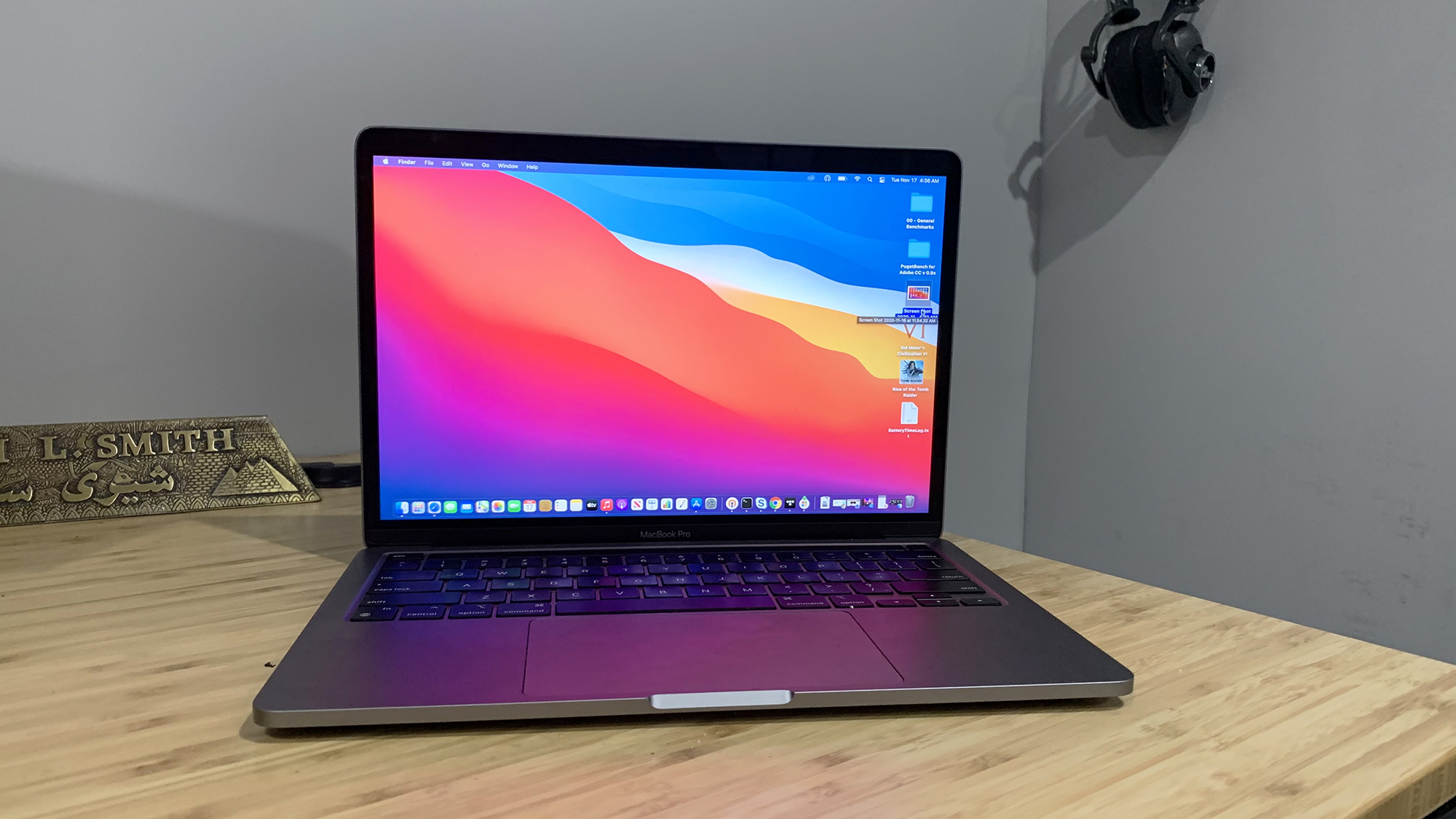Laptop Mag Verdict
Armed with Apple’s new M1 SoC, the MacBook Pro brings power, endurance and a host of new features in that familiar iconic chassis.
Pros
- +
Stellar overall and gaming performance
- +
Excellent battery life
- +
Lightning-fast SSD
- +
Great webcam
- +
Comfortable keyboard
- +
macOS Big Sur is a nice update
Cons
- -
Not enough ports
- -
Thick bezels
Why you can trust Laptop Mag
Price: $1,299 (starting); $1,899 (reviewed at)
CPU: Apple M1
GPU: Apple M1 GPU
RAM: 16GB
Storage: 1TB
Display: 13.3-inch, 2560 x 1600-pixel
Battery: 16:32
Size: 12 x 8.4 x 0.6 inches
Weight: 3 pounds
Opening the latest MacBook Pro’s box, it looks like every other MacBook to date. I mean it’s beautiful and stately, true, but there’s no hint of the promise lurking just beneath the aluminum chassis. And believe me, there is promise. It’s the promise of power, the promise of performance –– the promise of the future.
No, it doesn’t look like it, but this MacBook marks a new chapter in Apple computing, and computers as a whole. So what’s behind the monumental change? Apple’s new M1 processor, the much ballyhooed component that signals the company’s break from Intel in favor of custom silicon. And Apple wasn’t shy about touting all the implications with grandiose and seemingly unheard of claims that these new MacBooks would deliver 3.5x the CPU performance, 6x faster GPU performance and outperform 98% of PC laptops on the market.
Well I’m here to tell you that the hype train is well-founded, except maybe for that last one. It’s a bit of a whopper. But still, the MacBook Pro 13-inch M1 ($1,899 reviewed, $1,299 starting) delivers impressive performance and has the longest battery life I’ve seen on a Mac. If that’s not enough, paired with Big Sur, you get blistering webpage load times and a better webcam experience –– all thanks to Apple Silicon. In short, the new MacBook Pro is everything Apple said and more.
Apple MacBook Pro pricing and configuration
I had a blast reviewing the $1,899 configuration of the MacBook Pro which has the new Apple M1 SoC, 16GB of RAM, a 1TB SSD and Apple M1 graphics. The base model costs $1,299 and has the Apple M1 SoC (System on a Chip), 8GB and a 256GB SSD. The $2,299 version bumps the storage up to 2TB. Each laptop comes with a 13-inch, 2560 x 1600 Retina display.
Apple MacBook Pro design
What more is there to say about this iconic design? It’s a MacBook. Like its many predecessors before it, the entirety of the chassis is made of aluminum. While my review is colored Space Gray, it’s also available in Silver. The lid is bare except for the world famous glossy Apple logo.
The interior of the lid has more of that Space Gray aluminum that makes up the palm rest and keyboard deck. The majority of the palm rest is occupied by a huge touchpad. The keyboard sits in a slightly recessed deck flanked by a pair of slim speaker grilles.

The MacBook Pro (12 x 8.4 x 0.6 inches) is a bit on the heavy side at 3 pounds. The Dell XPS 13 (11.6 x 7.8 x 0.6 inches) and 13-inch HP Spectre x360 (12.1 x 7.7 x 0.7 inches) is slightly lighter at 2.8 and 2.7 pounds, while the Asus ZenBook 13 (UX325EA)’s 11.9 x 8 x 0.5-inch frame proved to be the slimmest and lightest at 2.5 pounds.
Sign up to receive The Snapshot, a free special dispatch from Laptop Mag, in your inbox.
Apple MacBook Pro security
The MacBook Pro comes with a host of security features designed to ensure your precious data remains for your eyes only. You have Touch ID fingerprint scanner cleverly hidden in the power button for quick, secure logins. The M1 chip also provides data encryption, hardware-verified secure boot, automatic high-performance encryption and advanced runtime protections as part of its Secure Enclave software.
Apple MacBook Pro ports

The 13-inch MacBook Pro continues to offer the bare minimum of ports with a headset jack on the right side and a pair of Thunderbolt ports. There is a silver lining in that the Thunderbolt ports support USB 4, which can dole out speeds of up to 40Gb/s and a maximum of 15W of power.
Still, I wish there were four Thunderbolt ports like we see on the 16-inch MacBook Pro.
Apple MacBook Pro display
It’s simply not a MacBook without the Retina Display. However, Apple continues to tweak the formula, adding innovative technologies such as TrueTone to the mix. The technology intelligently and almost imperceptibly adjusts the display’s color temperature based on how well or poorly lit the environment is, creating an optimal viewing experience at all times. The display also features P3 wide color gamut, which is a wider color spectrum than sRGB. That means more vibrant colors which is always a good thing.
Something I can really do without are the thick bezels surrounding the 13.3-inch, 2650 x 1600-pixel Retina display. When all of your competitors are making the effort to shrink the unsightly black bars to barely-there levels, it makes no sense that Apple hasn’t followed suit. Maybe next time.

The trailer for the upcoming Aretha Franklin biopic, Respect, was alive with color. My favorite scene had actress Jennifer Hudson, dressed in a rose red sweater with a powder pink blouse underneath. Her brown skin looked warm and healthy and the detail was so sharp, you could see the sunlight glinting off of individual strands of hair, showing off the chocolate lowlights throughout.
When we tested the MacBook Pro’s color reproduction capabilities, it registered 78.3% on the DCI-P3 gamut. That is short of our 84% premium laptop average. However, it’s still better than the Spectre (77.4%), the ZenBook (76.1%) and the XPS 13 (69.4%).
The MacBook Pro’s panel is also plenty bright, peaking at an average of 435 nits. That’s significantly brighter than the 386-nit average as well as the ZenBook (370 nits) and Spectre (369 nits). However, the XPS 13 was the brightest with 469 nits.
Apple MacBook Pro audio
Skinny speakers, big punch. I didn’t expect much from the MacBook Pro’s stereo speakers, but I was pleasantly surprised throughout my testing. As I listened to the Master version of Toni Braxton’s “Gotta Move On” on Tidal, my small living room/dining room was filled with the sound of cascading strings, slowly giving way to synthed-out keyboard and a strong beat –– all of this before the singer’s world-renowned sultry alto entered the soundscape.
Once it did, I could hear the breaths as she enunciated her words, particularly on the ts or a quick succession of ah, ah, ahs. H.E.R.’s electric guitar seared the track, adding its own mournful testimony to the sad love song.
Apple MacBook Pro keyboard and touchpad
Apple put the uncomfortable nightmare of its Butterfly keyboard behind it and my fingers are better for it. The company’s Magic keyboard delivers bouncy, firm feedback and combines that with large keycaps and generous key spacing. I spent hours writing this review and never felt any discomfort. I easily surpassed my 70 words per minute average, hitting 76 wpm on the 10fastfingers typing test.
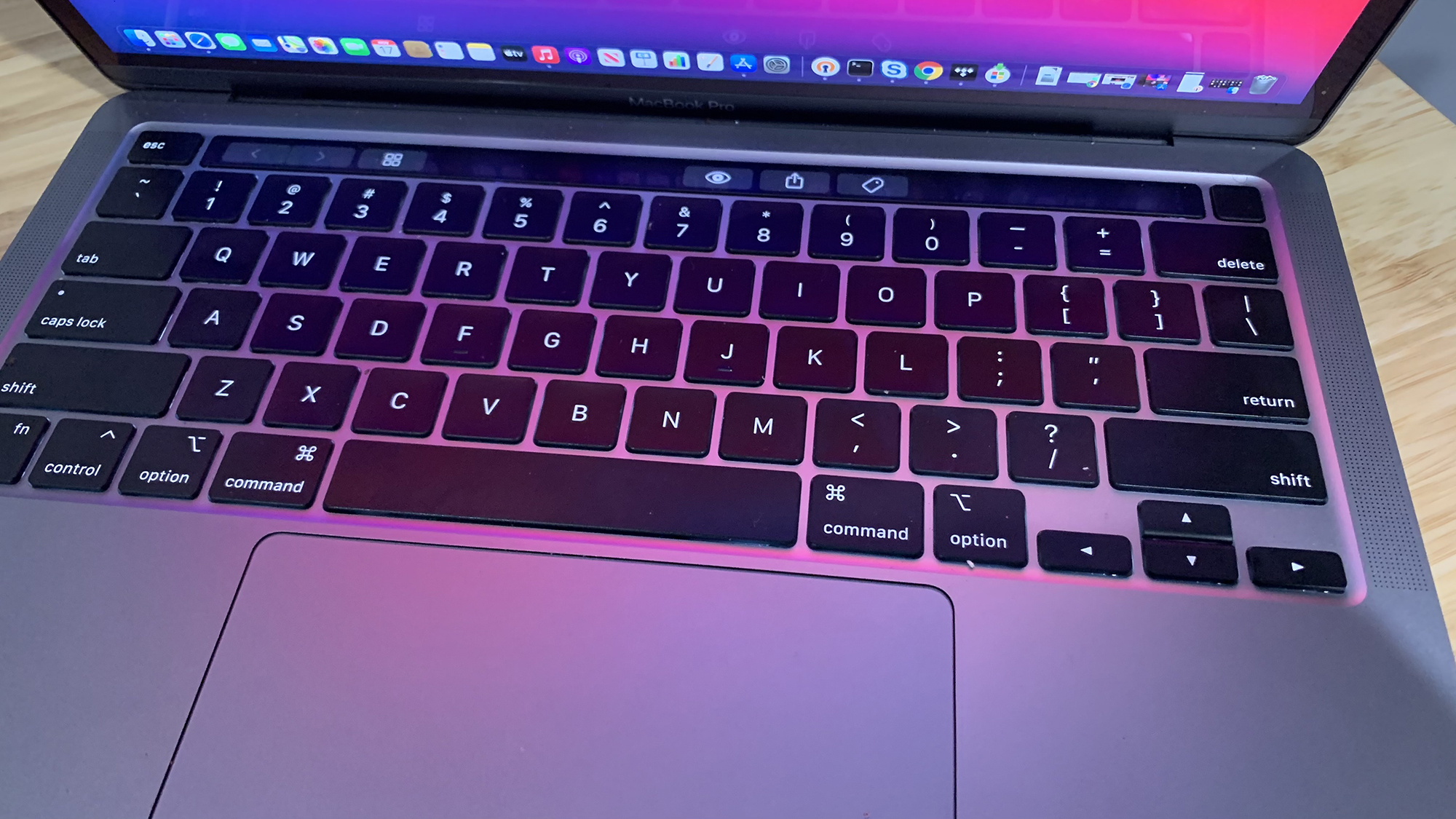
The backlighting underneath the keycaps is bright enough to use in darkened settings, which is good for the hunt-and-peck typists out there. And if you’re so inclined, the MacBook also has the TouchBar, which can serve up helpful shortcuts depending on the app currently running.
At 5.1 x 3.2 inches, the MacBook’s massive Force trackpad takes up most of the actual palm rest. There’s never a moment of running out of navigation space and, thanks to stellar palm rejection, the cursor never went careening off from where I left it due to inadvertent palm contact. I never had to worry about running out of space to navigate. The edges of the trackpad have firm feedback when you’re right or left-clicking.
Apple MacBook Pro M1
So what’s all the hub-bub about M1? Apple’s M1 custom SoC marks the first step in Apple’s conscious uncoupling from Intel, which Apple says will take two years to complete. The ARM-based 5-nanometer chip has 16 billion transistors, which is the most the company has ever put into a chip. In addition to all those transistors, the SoC features an eight-core processor, integrated graphics, a unified memory architecture, Apple’s Neural Engine, an improved image signal processor and Apple’s Secure Enclave.
Now that we know everything the SoC entails, let’s break a few components out, shall we?Starting with the processor and graphics card, theM1 features an eight-core CPU with four of the cores being dedicated to high performance and the remaining four focusing on efficiency. According to Apple, the high-performance cores will deliver industry-leading speeds on single-threaded tasks and when combined, they deliver a sizable boost to multithreaded performance. The performance cores deliver a 3.5x boost in CPU performance.
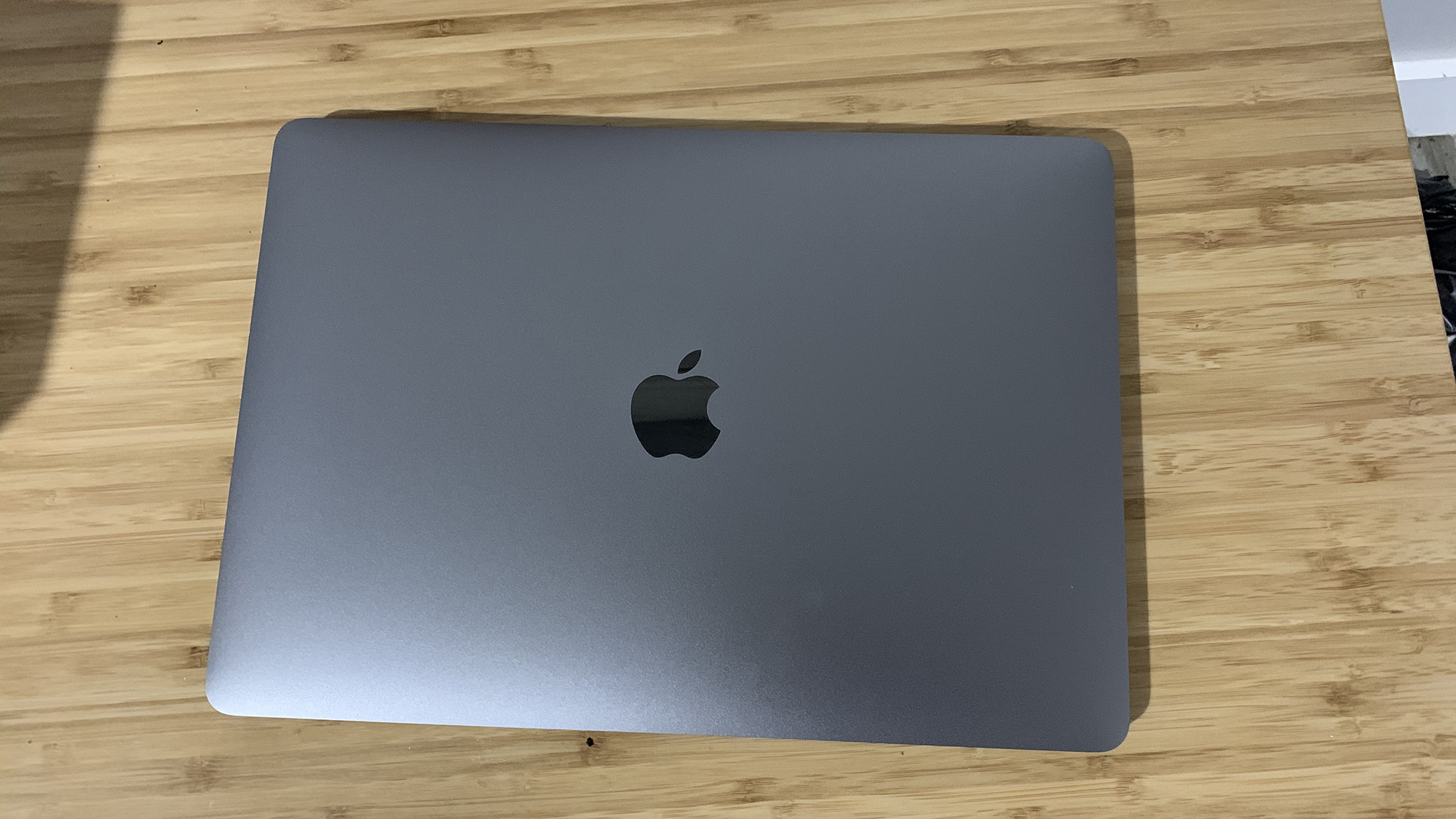
But don’t sleep on the high-efficiency cores; they allow those high-performance cores to do their thing, but using only one-tenth of the usual power output. Both sets of cores work in tandem with the help of the performance controller, which allows all of the cores to work simultaneously.
The MacBook Pro’s integrated graphics chip, the M1 GPU, has eight cores and, according to Apple, it is the world’s fastest integrated graphics in a laptop with up to 6x faster graphics performance. Each core has 128 execution units for demanding tasks. In addition, the M1 GPU is capable of executing nearly 25,000 threads, delivering 2.6 teraflops of performance. The Nvidia GeForce GTX 1050 Ti GPU has 2.1 teraflops. With all that power, the M1 GPU can process multistream 4K video playback in real time and handle massive image processing tasks. You’ll also have the ability to easily tweak 3D scenes as well as play games with higher frame rates.
Being that the M1 is made from custom ARM architecture, it means that MacBooks now uses Universal apps. These new apps can run on both macOS, iOS and iPadOS without any difficulty, automatically adjusting size and scale according to the device. It also means that the MacBook now has access to a huge library of apps. Any app that hasn’t made the switch to Universal will run in Rosetta 2, an emulator designed to run Intel-based apps.
Apple MacBook Pro performance
Now we’re getting to the brass tacks of the matter. Apple made a lot of lofty claims about M1, and with its 16GB of unified memory, the chip lives up to the hype. I had 50 tabs open in Google Chrome with some running Tweetdeck, Slack, YouTube, Tidal, Gmail, Google Sheets and Twitch and the MacBook Pro just chugged along with no signs of lag or hang time.
The notebook also did well on our synthetic benchmarks. Sarting with Geekbench 5.0, an overall performance test, the MacBook Pro achieved 5,882, surpassing the 4,215 premium laptop average. The XPS 13 (Intel Core i7-1165G7 CPU) came the closest to matching the MacBook with a score of 5,254 while the ZenBook (Intel Core i7-1165G7 CPU) reached 5,084. The Spectre and its 10th Gen Intel Core i7-1065G7 processor was at the tail end with only 4,074.
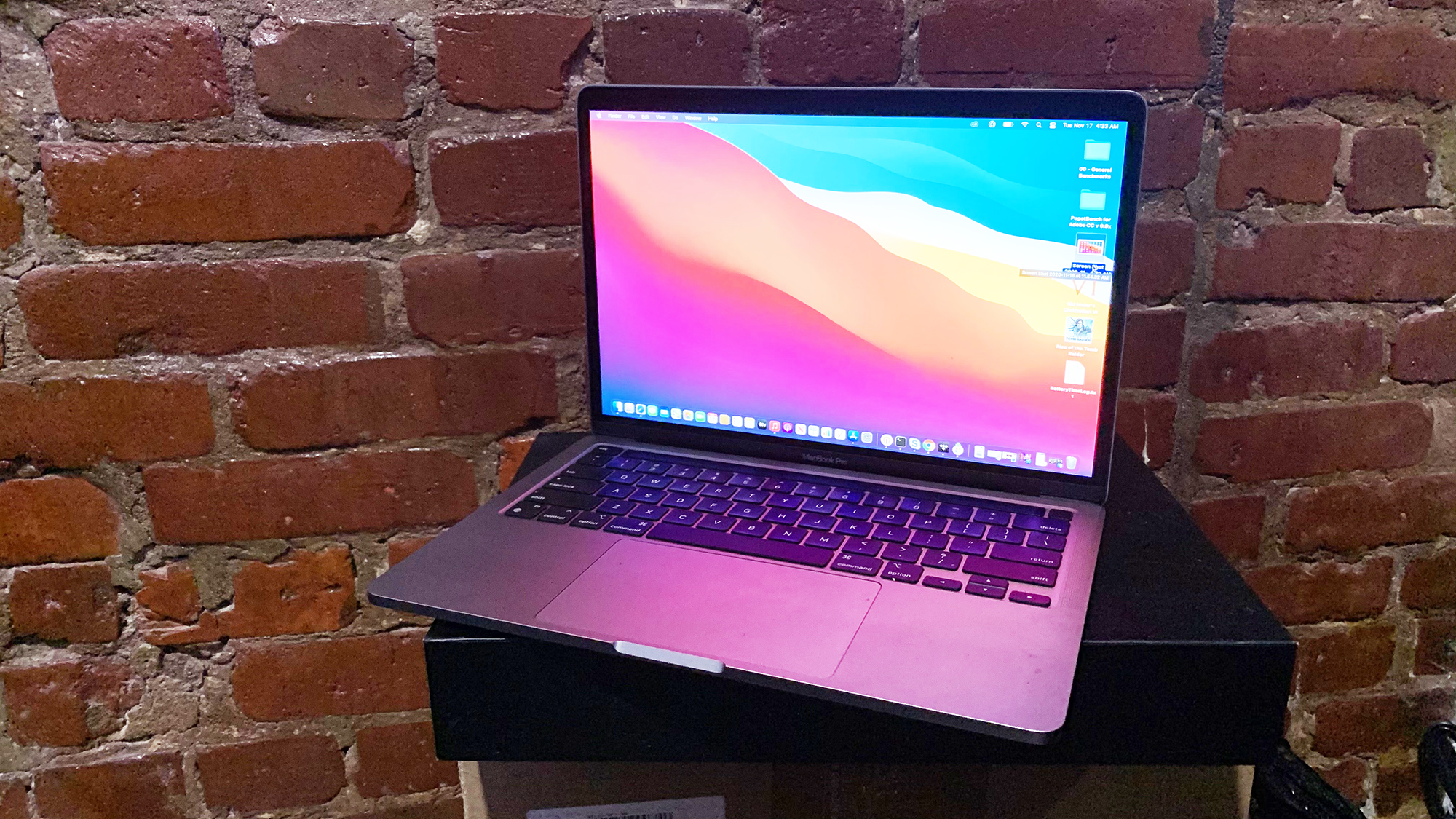
The MacBook Pro scorched the competition on the Handbrake benchmark where we have the laptop convert a 4K video to 1080p. On the Silicon Beta version of Handbrake, the MacBook clocked a time of 7 minutes and 44 seconds, during the Rosetta 2 iteration, the time rose to 13:38. Both times are still much faster than the competing systems. The ZenBook finished the task in 17:51, while the XPS 13 got a time of 18:22. The Spectre was the slowest at 21:13.
On the Puget Photoshop test, which loops through 21 different Photoshop tasks three times per run, the MacBook obtained 649, beating the 613 average and the XPS 13’s 588. However, the ZenBook got the win with a score of 742.
During the AfterEffects benchmark, the MacBook reached 708, surpassing the 651 category average.
When we ran the BlackMagic Disk Speed Test to test the MacBook Pro’s 1TB SSD speed, it got 2,824.9 megabytes per second on the read portion of the test and 2,752.4 MBps on the write portion of the test. Both scores are faster than their respective averages (2,012 MBps read, 2,028.3 MBps write).
Apple MacBook Pro graphics
With its integrated M1 GPU, the MacBook Pro can do something a little unexpected: run games.
When we ran the Rise of the Tomb Raider benchmark, we saw a frame rate of 29 frames per second at Very High on 1400 x 900. That’s several frames higher than the 24 fps premium laptop average. When we re-ran the test at 1080p, however, the frame rate dropped to 18 fps. The XPS 13 notched 12 fps, matching the ZenBook.
During the Sid Meier’s Civilization Gathering Storm test, the MacBook Pro notched 29 fps, beating the 28-fps average as well as the ZenBook and XPS 13, which reached 21 and 16 fps, respectively.
Apple MacBook Pro battery
The longest MacBook Pro battery life ever. Apple claims that the M1 MacBook Pro will last 20 hours if it’s straight video playback and 17 hours of web browsing. We didn’t get exactly those numbers, but the Pro came pretty close. The MacBook Pro lasted 16 hours, 32 minutes on the Laptop Mag Battery Test (continuous web surfing over Wi-Fi at 150 nits of brightness). That’s much longer than the 10:01 premium laptop average.
The ZenBook tapped out at 13:47 while the Spectre lasted 13:19. The XPS 13 finished with a time of 11:07.
Apple MacBook Pro MacOS Big Sur
What’s a new chipset without a new operating system? The new MacBook Pro (and Air) comes with macOS Big Sur. I’m not going to go too deep into everything you can expect (stay tuned for our upcoming review), but I wanted to talk about some of the more exciting new features.
First things first, Big Sur signals to what many in the industry are calling the “iPadification of the MacBook.” The fancy term simply refers to the Universal apps that will run natively on all Macs running Apple silicon as well as several new design features.
For instance, Big Sur gives users a Control Panel, which is kind of ironic since Microsoft is talking about ditching the feature. The macOS version gives instant to key utilities such as volume, Bluetooth, keyboard brightness and AirDrop to name a few. It’s not as robust as what’d you find on an iPad, but it’s a start. I like how you can pin things to the Menu Bar, although I had a bit of trouble removing them.
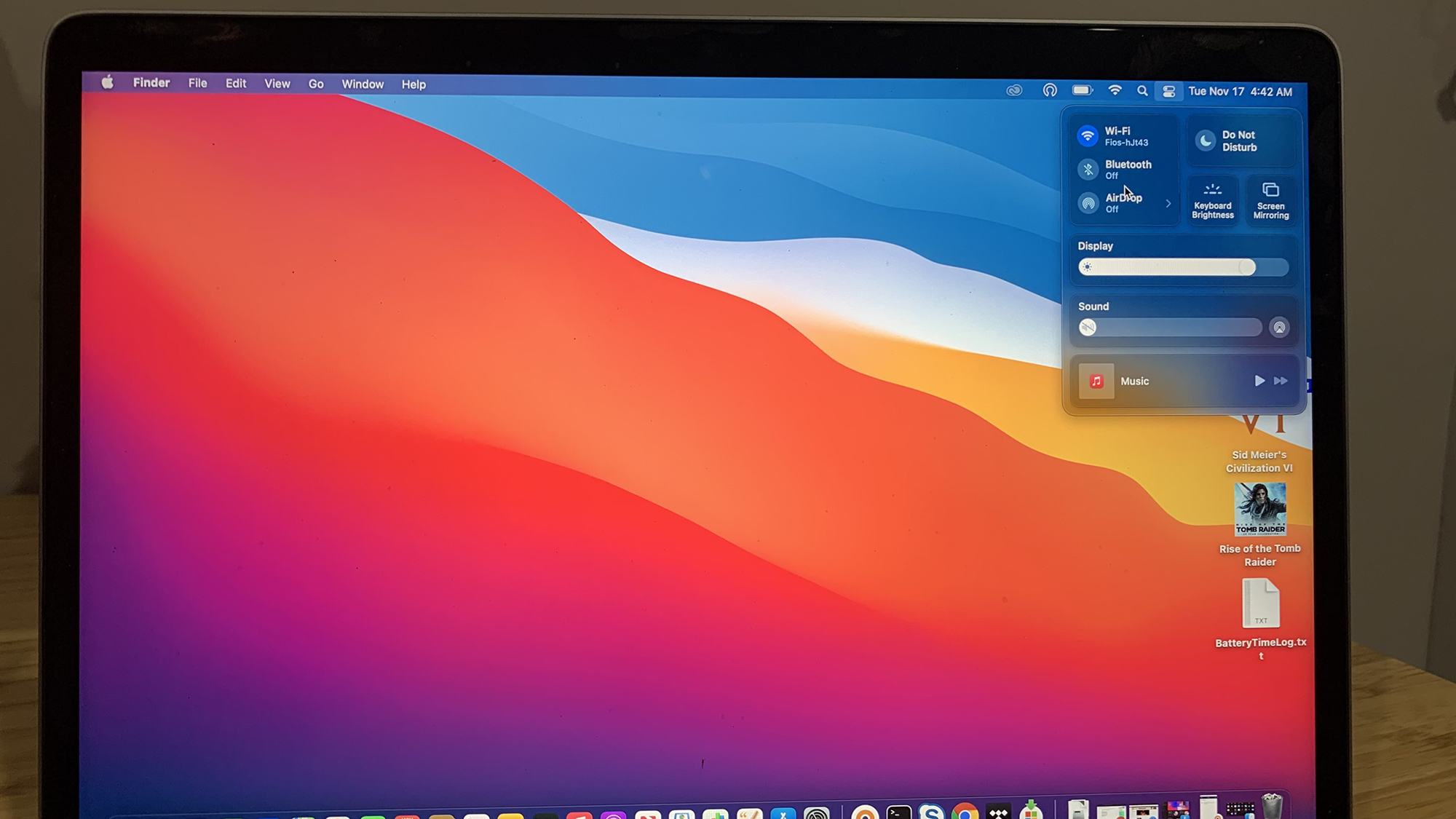
If you click the date and time in the top right corner of the Menu Bar, you’ll summon Widgets for ScreenTime, Stocks, Calendar and Weather, all of which can be arranged to your liking. You can also adjust the size. For now, the widgets aren’t as varied as I’d like, it’d be nice to have a few third-party widgets for Facebook or Spotify. Hopefully, we’ll get some variety and upcoming updates. Notifications have been incorporated into Widgets, grouping the info by app.
And I’d be remiss if I didn’t mention the new design. It’s gorgeous. Boasting a bright, bold color palette that just draws and keeps your attention. I’m a big fan of the translucent dock at the bottom and the squircle-shaped apps that occupy it. The apps share the same look and color scheme whether you’re on your iPhone, iPad or Mac which makes transitioning between the three that much easier.
Other cool Big Sur enhancements include an upgraded Apple Maps, an updated Messages app that allows you to pin conversations to the top of the list, reply inline to any message, or type someone’s name to message them directly. You can now create and edit Memojis on your Mac and, if you own a pair of AirPods, you can seamlessly switch between devices as long as they’re all on the same iCloud account.
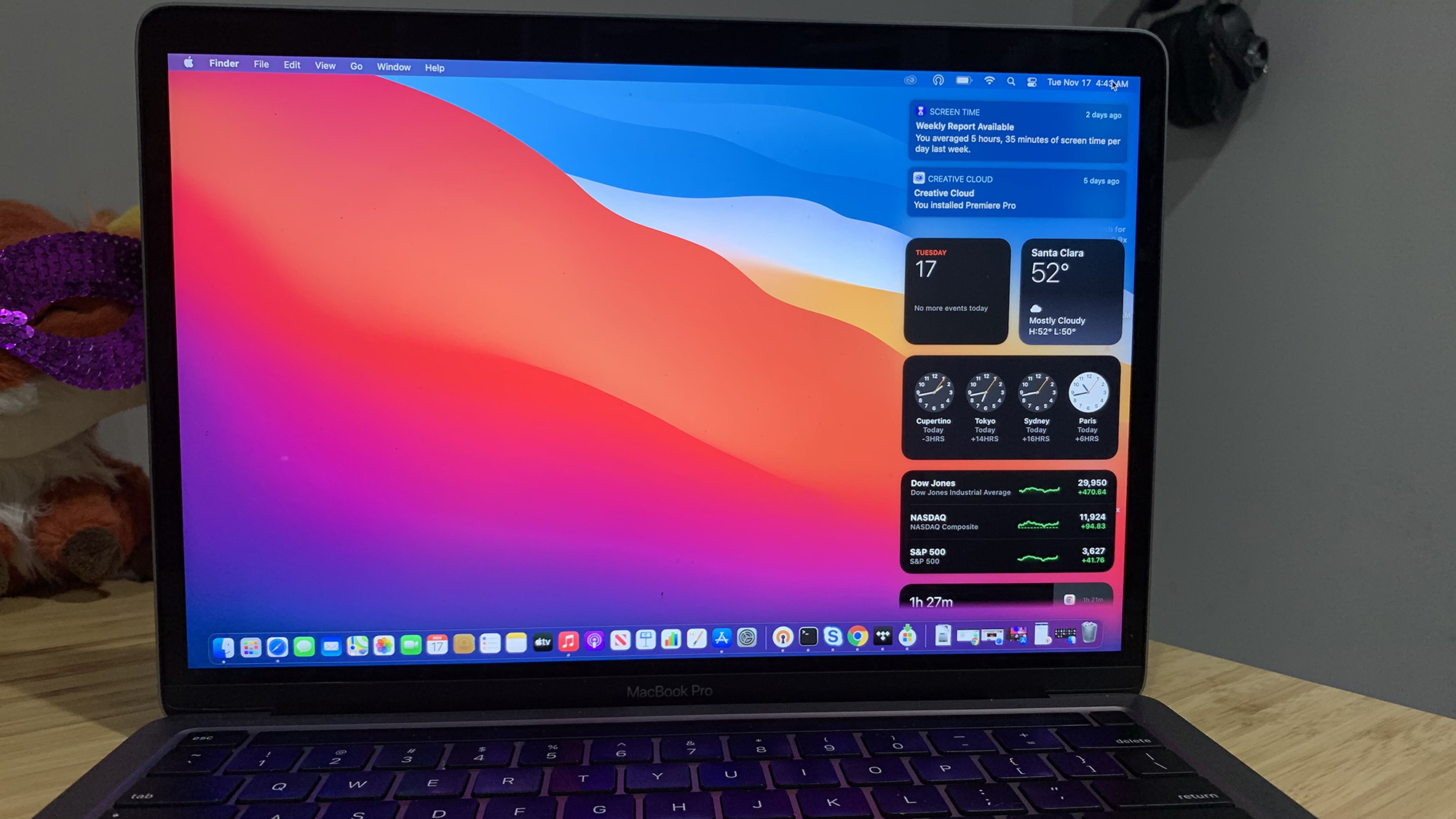
But the crown jewel of Big Sur is Safari. Now I’m a die-hard Chrome user, but Safari on Big Sur is so sleek and fast, I’m seriously considering using it as my default browser when I’m on a Mac. Similar to Chrome, you can set a different background image to load with every browsing session. You can also set Favorites, a collection of pinned apps for quick access. And if you like to spice up your browser experience with extensions, you now have a dedicated place in the App store to find the latest.
As someone who typically has more than 40 tabs open, I appreciate the way Safari handles its tabs. Not only do you get big, easily recognizable tabs, if you place the cursor over a tab you get a nice, big preview picture of the page which cuts down on tab confusion. Other cool features include translation, which can instantly decipher a page into seven languages. As an added measure of security, Safari offers password monitoring, which lets you know if your passwords have been compromised. There’s also Privacy Report, which prevents companies from tracking you when you visit a website.
But what really blew me away was the speed, particularly when loading websites. Laptop Mag took only 0:79 seconds to load where Chrome clocked in with a time of 2.66. When I loaded Tweetdeck on Safari, it only took 2:17 to load up all my columns, which is much faster than the 10:10 Chrome delivered. Safari took 2:34 to load ESPN while Chrome had a time of 4:71.
Apple MacBook Pro heat
Unlike the Air, the MacBook Pro has an active cooling system to keep things nice and frosty. The fan remained quiet even when I was running 40 tabs and Rise of the Tomb Raider. When we ran our heat test (running a 15 minute fullscreen HD video) the touchpad measured 78 degrees Fahrenheit, which is well below our 95-degree comfort threshold. The touchpad and undercarriage were just as cool with temperatures of 81 and 83 degrees, respectively.
Apple MacBook Pro webcam
It might only have 720p resolution, but the MacBook Pro’s webcam might be one of the best I’ve used to date. Thanks to the image signal processor in the M1 chip, the FaceTime camera offers stellar video quality with better automatic white balance, greater dynamic range and improved noise reduction.

I used the laptop for several video calls during the course of this review and got rave reviews. My colleagues reported crisp, clear images with great color reproduction. In fact, someone complimented me for matching my shirt to my hair color. And even though the sun was pouring in through the window, the white balance made me look dewy and fresh-faced instead of washed-out and over-exposed. The new three-mic array made sure that my words were coming in loud and clear.
Apple MacBook Pro warranty
See how Apple fared on Tech Support Showdown and Best and Worst Brands, our annual special reports.
Bottom line
Call it the emancipation of Apple, the company’s freedom song or just plain liberation. With the advent of the M1 chip, Apple is free –– free to be faster and stronger, free to dominate. And the company’s wasting no time in asserting its dominance. Not only does the 13-inch MacBook Pro with M1 have better overall and graphics performance, it has some of the longest battery life we’ve ever seen on a laptop.
Apple could have stopped there, but instead, you get faster web page loading times, a more powerful camera and seamless integration between Mac, iPad and iPhone thanks to native Universal apps. The 5nm chip even improves the camera and microphones.
However, with all this impressive power, it would have been nice to get a new design, or at least a new color. Some other things that continue to grace our MacBook wishlist are slimmer bezels and more ports. If you are looking to save a few bucks and get somewhat comparable performance and a brighter display, consider the $999 Asus ZenBook UX325EA. But if you’re looking for the fastest, most powerful premium laptop in the land, say hello to the new king.

Sherri L. Smith has been cranking out product reviews for Laptopmag.com since 2011. In that time, she's reviewed more than her share of laptops, tablets, smartphones and everything in between. The resident gamer and audio junkie, Sherri was previously a managing editor for Black Web 2.0 and contributed to BET.Com and Popgadget.
